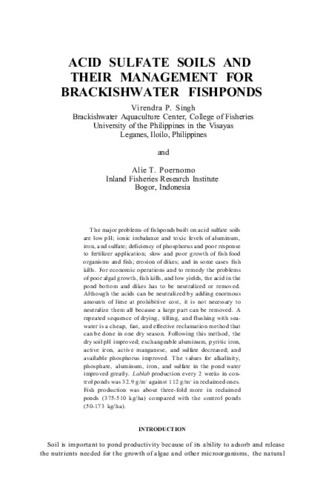Acid sulfate soils and their management for brackishwater fishponds
Share
นามธรรม
The major problems of fishponds build on acid sulfate soils are low pH; ionic imbalance and toxic levels of aluminum, iron, and sulfate; deficiency of phosphorus and poor response to fertilizer application; slow and poor growth of fish food organisms and fish; erosion of dikes; and in some cases fish kills. For economic operations and to remedy the problems of poor algal growth, fish kills and low yields, the acid in the pond bottom and dikes has to be neutralized or removed. A repeated sequence of drying, tilling, and flushing with seawater is a cheap, fast, and effective reclamation method that can be done in one dry season. Following this method, the dry soil pH improved; exchangeable aluminum, pyritic iron, active iron, active manganese, and sulfate decreased; and available phorphorus improved. The values for alkalinity, phosphate, aluminum, iron, and sulfate in the pond water improved greatly. Fish production was about three-fold more in reclaimed ponds (375-510 kg/ha) compared with the control ponds (50-173 kg/ha).
การอ้างอิง
Singh, V. P., & Poernomo, A. T. (1984). Acid sulfate soils and their management for brackishwater fishponds. In J. V. Juario, R. P. Ferraris, & L. V. Benitez (Eds.), Advances in milkfish biology and culture: Proceedings of the Second International Milkfish Aquaculture Conference, 4-8 October 1983, Iloilo City, Philippines. (pp. 121-132). Metro Manila, Philippines: Published by Island Pub. House in association with the Aquaculture Department, Southeast Asian Fisheries Development Center and the International Development Research Centre.


